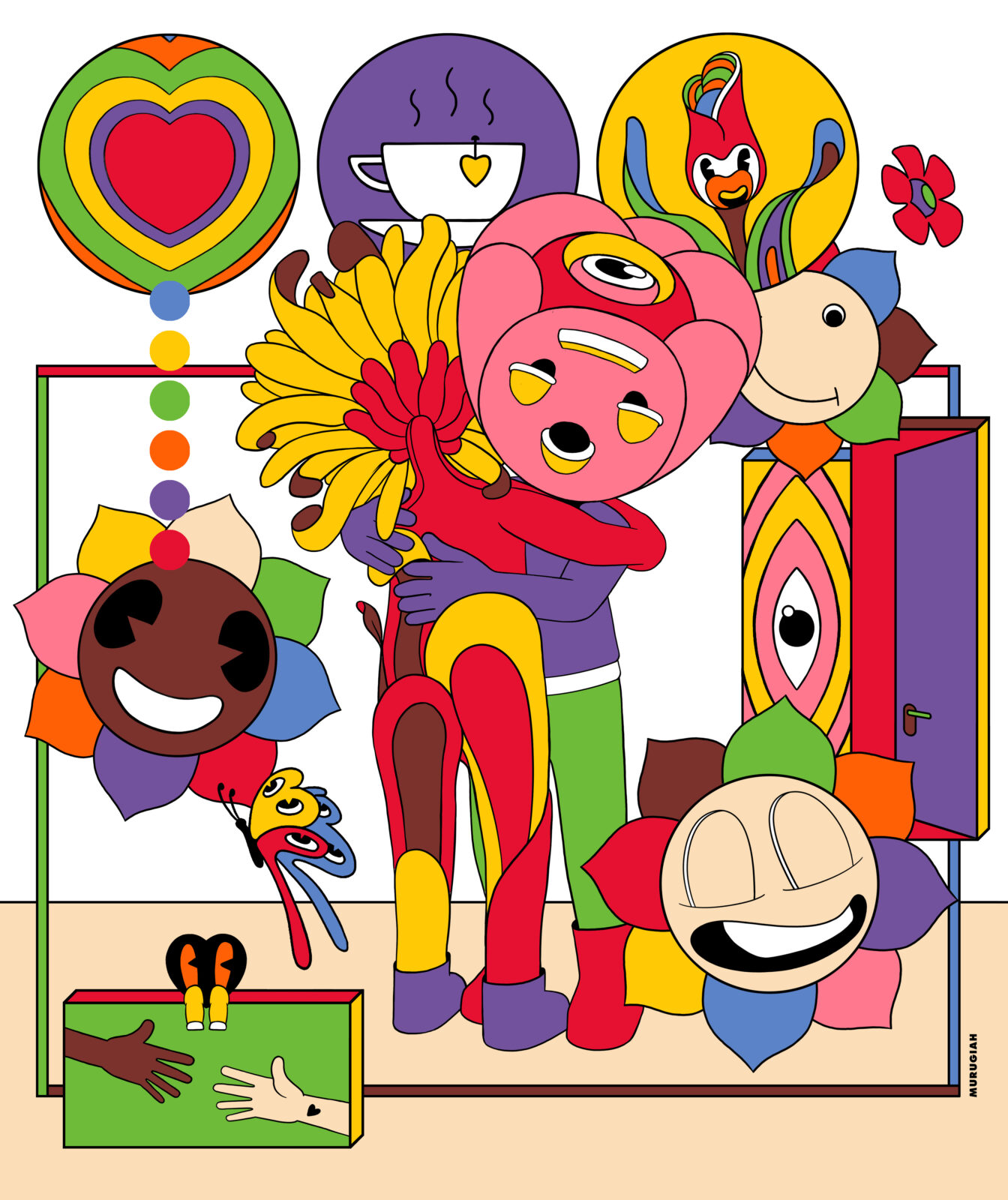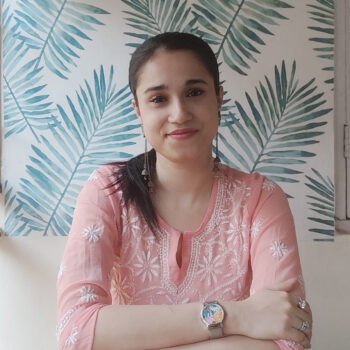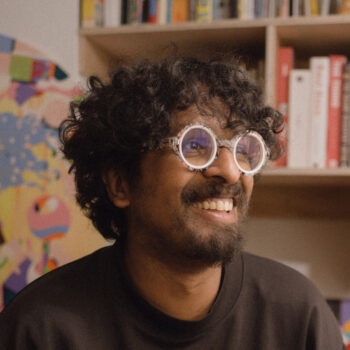
Illustration by Murugiah

Illustration by Murugiah
I still remember the day I ordered ice online for the first time.
It sounds absurd, right? Who orders ice when you can just freeze it at home? But as a disabled person living with multiple chronic illnesses, I don’t always have the luxury of spare “spoons”—a metaphor within the disabled community for the limited energy reserves most of us live with. Add to that the relentless grip of executive dysfunction, and you’ve got yourself a combination that can make even the simplest tasks feel insurmountable. So . . . I ordered ice.
But when this came up in conversations with my neurotypical, able-bodied friends, I could see them struggling to disguise their almost-instinctive judgment as curiosity: “Interesting. Why couldn’t you freeze some yourself? Is your freezer out of order?”
This seemingly innocuous question is rooted in a broader societal issue—the unnecessary glorification of independence. For disabled people like me, this glorification is more than just a cultural quirk. It’s a form of ableism that marginalizes our experiences and erodes our sense of self-worth.
In our society independence is often seen as the ultimate goal, a marker of success, maturity, and self-sufficiency. The expectation is clear: overcome your limitations and strive for independence in every aspect of life, from earning a livelihood to living alone. But this one-size-fits-all standard fails to consider the individual realities of people who simply can’t meet these expectations without significant harm to their mental and physical health.
Having grown up conditioned by these expectations, the pressure to be independent isn’t just external—we internalize it. We absorb these messages and push ourselves to the brink of burnout trying to meet them. I’ve experienced this firsthand. There have been days when I’ve attempted to tackle basic household tasks while managing a full-time job and taking care of a cat—like my able-bodied, neurotypical friends—only to be completely wiped out, unable to do anything for the rest of the day.
My partner—who is also diagnosed with ADHD—faces similar struggles.
Together we’ve had to accept that we can’t always do it all, and that’s okay. But it took both of us a lot of time—nearly three decades—to get there, and we’re not even fully there yet. We’re merely works in inconsistent progress. It’s a lesson that’s hard to hold on to in a world that constantly tells us if we’re not independent, we’re basically “good-for-nothing losers.”
In 2012, Lydia X. Z. Brown, an autistic disability rights activist, wrote, “It is presumed on our behalf that the goal for our lives should be as much independence as possible with as few supports as possible, including accommodations and services.”
More than a decade later, even in the aftermath of a pandemic, things haven’t changed much. A couple years ago, a disabled man living with spastic diplegia cerebral palsy recounted to me his tryst with the notion of independence as a universal goal. “I have even received forwarded WhatsApp videos from my father, which have ‘inspiration porn,’” he said, “with him adding that even I should try to be independent as much as possible.”
This glorification of independence is not just harmful to disabled people—it’s also fundamentally flawed. Human beings are, by nature, interdependent. Yet in this single-minded obsession with independence, many fail to recognize that independence is not synonymous with self-sufficiency. True independence is about having the freedom to make choices about how to live, including the choice to ask for help when needed. This is where the concept of interdependence comes in.
True independence is about having the freedom to make choices about how to live, including the choice to ask for help when needed.
Interdependence—far from being a radical or new concept—is deeply rooted in the human experience. It acknowledges that we all rely on one another in various ways and that this reliance is not a sign of weakness but a fundamental aspect of being human. We have always thrived in communities, relying on one another for support, cooperation, and survival. This isn’t weakness. It’s the foundation of human civilization.
In a world that idolizes hyper-independence, it’s easy to forget how much we already depend on others. Consider the simple act of brewing a cup of tea in the morning. It’s something my partner and I rarely have the spoons to do, and people with no real understanding of our struggles have shamed us for ordering tea instead.
To those people, I’d like to ask, do you grow your own tea leaves? Let me guess, probably not. You rely on farmers, distributors, and retailers to enable you to blissfully nurse that warm cup of tea in your hands and sip it as you listen to bird sounds emanating from trees that you probably didn’t plant yourself either.
The same goes for countless other aspects of daily life. Yet because these forms of interdependence are normalized by society, they go unnoticed. In contrast, when disabled people—especially those with invisible disabilities—seek accommodations and support, it’s often seen as a burden and equated with a failure to achieve independence.
This double standard is not only unjust but also perpetuates the stigma surrounding disability.
When we embrace interdependence fully, we create a society that values all its members, not just those who fit the mold of independence. This shift in perspective can have profound implications since, believe it or not, hyper-independence isn’t just ableist, it’s also a trauma response arising from a place of fear, from the need to protect oneself by refusing help and taking on more than one can handle. Unsurprisingly, this leads to feelings of isolation, loneliness, and burnout among disabled and able-bodied folks alike.
In my life, the sunflower lanyard—officially described as “a discreet sign that the wearer has a hidden disability and may need additional support”—is a symbol of the interdependence I’m striving for. When I put it on for the first time at the Bengaluru airport, a sense of liberation from the ideal of independence washed over me.
For the first time, I felt empowered to ask for help without the usual anxiety that accompanies such requests. The lanyard signaled to the world that I may need extra support, and in doing so, it freed me from the pressure to pretend that I didn’t. It was almost like a small act of self-advocacy, one that allowed me to navigate an overwhelming environment at my own pace, instead of drowning in the sense of shame and self-hate that usually accompanies the sensory overload at airports and pushes me to the brink of a meltdown.
The sunflower lanyard reminds me that asking for help is simply a recognition of our shared humanity, and that it’s okay to function on crip time.
This is the world I want to live in—one where I don’t have to justify ordering ice and tea, or wearing a sunflower lanyard, and where my need for support is met with understanding rather than judgment. It’s a world where we all belong, not because we’ve achieved some arbitrary standard of independence, but because we’ve recognized the strength that comes from relying on one another.

Devrupa Rakshit is an award-winning independent journalist, social media consultant, new media artist, and disability rights advocate based in India. Her work—which focuses on the intersections of mental health, gender, and social justice, particularly through the lens of disability and neurodivergence—has appeared in several national and international publications. A former lawyer, Devrupa is also a bilingual poet and regularly performs spoken word poetry on anti-establishment themes directed at challenging exclusionary and unsustainable societal norms.

Murugiah is a multidisciplinary British Sri Lankan artist, illustrator and designer working in London. Using a colorful, surreal visual aesthetic, he playfully explores the macabre, bittersweet, and joyful experience of his daily life and identity. Infused with candy-coated dreams and peppered with South Asian motifs, his work—encompassing film, architecture, art, and design—resonates with those seeking kindness, authenticity, and compassion. See his work at murugiah.com and @_murugiah
Get the latest news and stories from the Rubin, plus occasional information on how to support our work.